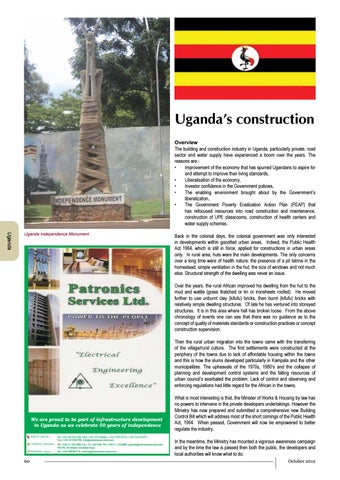Uganda’s construction Overview The building and construction industry in Uganda, particularly private, road sector and water supply have experienced a boom over the years. The reasons are:• Improvement of the economy that has spurred Ugandans to aspire for and attempt to improve their living standards, • Liberalisation of the economy, • Investor confidence in the Government policies, • The enabling environment brought about by the Government’s liberalization,. • The Government Poverty Eradication Action Plan (PEAP) that has refocused resources into road construction and maintenance, construction of UPE classrooms, construction of health centers and water supply schemes.. Uganda
Uganda Independence Monument
Back in the colonial days, the colonial government was only interested in developments within gazetted urban areas. Indeed, the Public Health Act 1964, which is still in force, applied for constructions in urban areas only. In rural area, huts were the main developments. The only concerns over a long time were of health nature: the presence of a pit latrine in the homestead, simple ventilation in the hut, the size of windows and not much else. Structural strength of the dwelling was never an issue. Over the years, the rural African improved his dwelling from the hut to the mud and wattle (grass thatched or tin or ironsheets roofed). He moved further to use unburnt clay (kifufu) bricks, then burnt (kifufu) bricks with relatively simple dwelling structures. Of late he has ventured into storeyed structures. It is in this area where hell has broken loose. From the above chronology of events one can see that there was no guidance as to the concept of quality of materials standards or construction practices or concept construction supervision. Then the rural urban migration into the towns came with the transferring of the village/rural culture. The first settlements were constructed at the periphery of the towns due to lack of affordable housing within the towns and this is how the slums developed particularly in Kampala and the other municipalities. The upheavals of the 1970s, 1980’s and the collapse of planning and development control systems and the falling resources of urban council’s exerbated the problem. Lack of control and observing and enforcing regulations had little regard for the African in the towns.
We are proud to be part of infrastructure development in Uganda as we celebrate 50 years of independence Tel: +254 20 6532790, Mob: +254 774139484, +254 733519774, +254 722519774 Fax: +254 20 6532783. info@patronicsservices.com Tel: +256 41 4341685. Fax: +41 4341694. Tel: +256 41 4344838. uganda@patronicsservices.com Plot 99, 6th Street, Industrial Area. Tel: +250 788381715. rwanda@patronicsservices.com
60
What is most interesting is that, the Minister of Works & Housing by law has no powers to intervene in the private developers undertakings. However the Ministry has now prepared and submitted a comprehensive new Building Control Bill which will address most of the short comings of the Public Health Act, 1964. When passed, Government will now be empowered to better regulate the industry. In the meantime, the Ministry has mounted a vigorous awareness campaign and by the time the law is passed then both the public, the developers and local authorities will know what to do. October 2012
